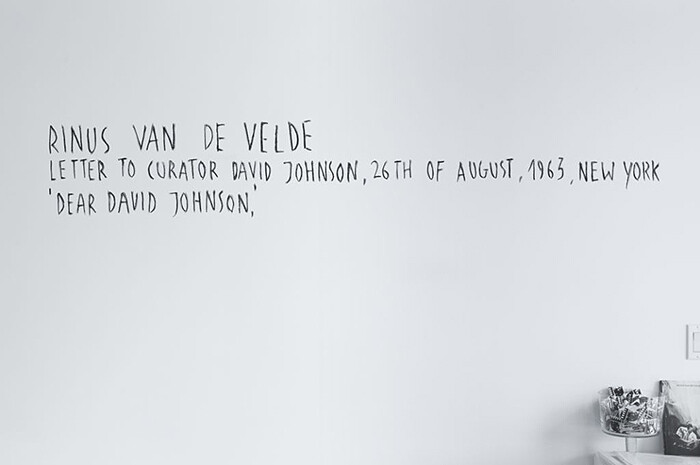Combining realist fiction with strains of truthiness, Rinus Van de Velde harnesses our contemporary compulsion for storytelling for its own sake, stating, “although the stories I create are fictional, I still try to believe in them.” But he also employs fiction as a literary device to undercut a host of cultural clichés. Unafraid of irony, reflexivity, and the old fashioned morality tale, “Dear David Johnson,” one chapter in an ever-developing fake autobiography, examines art world perversions and other bewildering ontological issues embedded in the creation of art. Undercurrents of social networking collide with postmodern critical theory in Van de Velde’s floor-to-ceiling wall-written pages. The all-over hand-scribed text is punctuated with charcoal drawings that loosely illustrate the seven-paragraph letter of nearly a thousand words, to the fictional curator David Johnson. Engulfing the gallery, the installation of text and images creates a dramatic and dwarfing effect on the viewer, as if one has been dropped onto the parchment of an artist’s journal.
Addressed to David Johnson, the letter dated August 26th, 1963, is an apology and a defense for missing a scheduled appointment with the curator. In the grip of an existential crisis albeit an old artist-genius cliché, the author of the letter, the fictional Rinus Van de Velde explains to Johnson, “Two months ago I had to spend a couple of days at a immense art event. A dense multitude of fake walls displayed about a billion artworks. No overview, busy buyers, long lunches, tired eyes. ‘Hey here,’ ‘hullo there,’ ‘what about a drink afterwards,’ and ‘could we meet to discuss your work.’ It was the metaphorical labyrinth of the contemporary art world turned real.” The letter then goes on to detail that while he was on his way to meet up with Johnson, Van de Velde discovered a discarded portrait of a mustached man on the street, explaining that although poorly painted it was “authentic, if you will allow me to use that word; it transcended ratio, tradition and artistic mannerism.” Identifying the “authentic” changed everything for the artist who in an instance of great clarity needed to “rid myself of these new aristocrats of contemporary art, these prophets of a cynical self-consciousness! To be naked and start over again! To see through blind eyes!” So he missed their meeting and hopped on a plane to Nepal.
Van de Velde, the contemporary Belgian artist marries his fictional autobiography with images that he pulls from the web and translates into large charcoal drawings on paper. He makes a regular practice of tolling for images that crudely authenticate his stories. Take for instance the drawing RVDV01-0561 (2011) showing a man pinning up an artwork among a host of primitive-like compositions. Derived from a photograph, this drawing, along with the others included in his Chicago project, has pronounced parallels with the work of Mark Tansey; appropriated, representational, and monochromatic imagery that aims to retell cultural histories with an authoritative, satirical punch. His illustrated narratives critically expose the hierarchical conventions that comprise art’s contemporary apparatus. It also is steeped in the ironically, affirming creative genius truisms that hold sway in both popular imagination and the professional art world. Unlike many of the fictional characters aliases, mystifications, avatars, and pseudonyms navigating through the contemporary artworld (from John Dogg to Reena Spaulings), Van de Velde’s Van de Velde is unabashedly critical, wry, and trenchant. There is nothing ambiguous nor poetic about his fictional position with the exception of the relationship between the nearly academic charcoal drawings and the writing.
As with all the drawings, there is no invention in the pictorial content. In the translation from found image to charcoal drawing details are lost and replaced with the limitations of the drawing process. The charcoal representations are accurate and convincing depictions of their source yet they are also tirelessly quick and un-labored. RVDV01 (2011) depicts the lower legs of a man wearing pressed and cuffed trousers and a pair of stylish shoes. The back leg falls into dense shadow but the shoes are caught in the brilliance of direct sunlight, a visual beacon and the central metaphor in this chapter.
So and that’s all there really is to tell about my trip to Nepal: I went there and sat down and looked into the abysses of the self and came back healthier, but still the same man. I made self-portraits and they were smart and fabulous. The thing is: you cannot undo yourself and start a different story. I am in this too far, caught in a self-spun web, and forever infected with the disease of consciousness. I am an artist and I will wear these fancy dinner party shoes with dignity. Let’s meet soon.
Yours truly, Rinus Van de Velde





